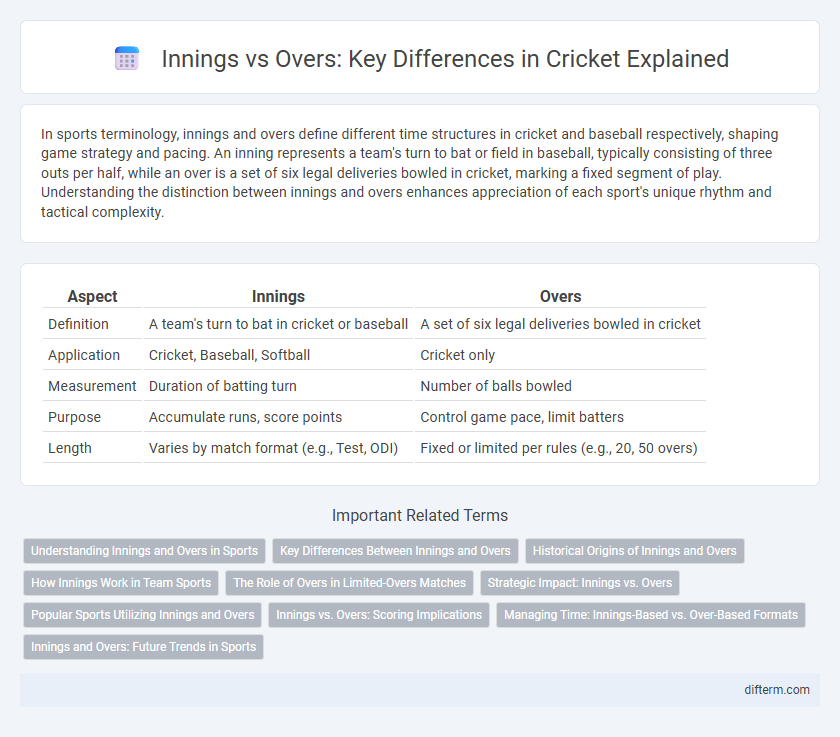In sports terminology, innings and overs define different time structures in cricket and baseball respectively, shaping game strategy and pacing. An inning represents a team's turn to bat or field in baseball, typically consisting of three outs per half, while an over is a set of six legal deliveries bowled in cricket, marking a fixed segment of play. Understanding the distinction between innings and overs enhances appreciation of each sport's unique rhythm and tactical complexity.
Table of Comparison
| Aspect | Innings | Overs |
|---|---|---|
| Definition | A team's turn to bat in cricket or baseball | A set of six legal deliveries bowled in cricket |
| Application | Cricket, Baseball, Softball | Cricket only |
| Measurement | Duration of batting turn | Number of balls bowled |
| Purpose | Accumulate runs, score points | Control game pace, limit batters |
| Length | Varies by match format (e.g., Test, ODI) | Fixed or limited per rules (e.g., 20, 50 overs) |
Understanding Innings and Overs in Sports
Innings and overs are fundamental concepts in cricket, with an inning representing a team's turn to bat and attempt to score runs, while an over consists of six legal deliveries bowled by one bowler. Each cricket match format, such as Test, One Day International (ODI), or Twenty20 (T20), dictates the number of innings and overs, influencing game strategy and pacing. Understanding innings and overs is critical for analyzing match progress, player performance, and tactical decisions during the game.
Key Differences Between Innings and Overs
Innings refer to a set period during which one team bats and attempts to score runs, typically ending when ten players are out or a predetermined time or overs limit is reached. Overs consist of six legal deliveries bowled by a single bowler, forming a fundamental unit of play that governs the pace and strategy of the game. The key difference lies in innings representing a team's entire turn at batting, while overs measure the specific number of deliveries bowled within that innings.
Historical Origins of Innings and Overs
Innings and overs originated from the evolution of cricket during the 16th and 17th centuries in England, where innings defined a team's turn at bat, reflecting the game's early emphasis on turn-based play. Overs, initially introduced in the 19th century, standardized the number of legal deliveries bowled, enhancing fairness and structure within matches. These historical elements shaped modern cricket's strategic framework, balancing offensive and defensive tactics through regulated play segments.
How Innings Work in Team Sports
In team sports like cricket and baseball, innings represent a team's turn to bat or play offense while the opposing team fields or defends. Each inning consists of a set number of outs or dismissals, such as three outs in baseball or ten wickets in cricket, after which teams switch roles. Unlike overs, which are specific to cricket and involve a fixed number of legal deliveries bowled, innings encompass the broader timeframe for each team's offensive opportunity during the match.
The Role of Overs in Limited-Overs Matches
Overs define the structure and pacing of limited-overs cricket matches by setting a fixed number of deliveries each team can face, typically 20 in T20 or 50 in One Day Internationals (ODIs). This format contrasts with innings-based formats where duration is not strictly limited by the number of balls but by time or wickets, making overs crucial for strategizing run rates and bowling changes. The deliberate restriction of overs intensifies gameplay urgency, influencing batting aggression and fielding tactics to maximize scoring within the allotted deliveries.
Strategic Impact: Innings vs. Overs
Innings structure allows teams to develop long-term strategies focusing on pacing and resource management over an extended period, maximizing player endurance and tactical depth. Overs constraints impose a fixed number of deliveries, driving aggressive playstyles and immediate scoring pressure that prioritize quick decision-making and adaptability. The strategic impact between innings and overs fundamentally shapes team composition, risk assessment, and momentum control in cricket and other limited-overs sports.
Popular Sports Utilizing Innings and Overs
Cricket is the most prominent sport utilizing both innings and overs, where each team bats in a fixed number of overs per innings, commonly 20 or 50 in formats like T20 and ODI. Baseball also features innings, with each team alternating between batting and fielding without overs, defining the game's turn structure. Softball, similar to baseball, employs innings but does not use overs, highlighting key structural differences in sports managing playtime and game phases.
Innings vs. Overs: Scoring Implications
In cricket, an innings represents the phase where a team bats until ten players are out or a set number of overs are completed, directly impacting scoring potential. Overs consist of six legal deliveries, and the number of available overs dictates the pace at which runs must be scored, influencing strategic decisions. The scoring implications of innings versus overs hinge on balancing aggression and preservation to maximize total runs within the allotted overs.
Managing Time: Innings-Based vs. Over-Based Formats
Innings-based formats allocate a fixed number of batting opportunities, allowing teams to strategize pacing and resource management over potentially unlimited deliveries within each innings. Over-based formats limit the number of deliveries per innings, forcing teams to maximize scoring efficiency and accelerate run rates within the predetermined set of overs. Effective time management differs significantly, with innings formats emphasizing endurance and adaptability, while overs formats prioritize precision and aggression under strict delivery constraints.
Innings and Overs: Future Trends in Sports
Innings and overs remain fundamental components in cricket, shaping strategies and game dynamics as the sport evolves. Emerging technologies like real-time data analytics and AI-powered performance tracking are enhancing how innings progress and overs are managed, optimizing player decisions and fan engagement. Future trends indicate increased integration of virtual reality and smart stadiums to provide immersive experiences during innings and overs, revolutionizing the way audiences interact with cricket.
innings vs overs Infographic

 difterm.com
difterm.com